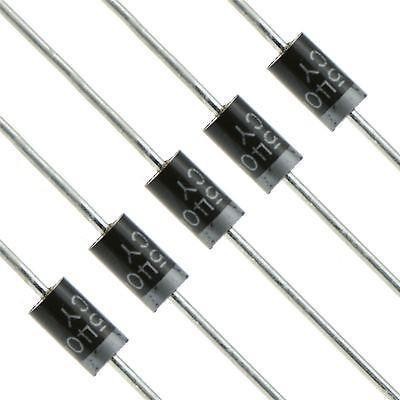Diode
A diode is a semiconductor device that allows electrical current to flow in one direction while blocking it in the opposite direction, functioning as a one-way valve for current. The most common type of diode is the PN junction diode, made by joining two different types of semiconductor materials: p-type (positive) and n-type (negative). The interface between these materials forms a PN junction, creating an area called the depletion region where no charge carriers (electrons or holes) exist, thus preventing current flow. When the diode is forward biased (positive voltage applied to the p-side and negative to the n-side), the depletion region narrows, allowing current to flow through. When the diode is reverse biased (positive voltage to the n-side and negative to the p-side), the depletion region widens, blocking current flow.
Diodes have a wide range of applications in electronics, the most common being rectification. Rectifier diodes are used to convert alternating current (AC) to direct current (DC) in power supplies. In this process, the diodes only allow current to pass during one half of the AC cycle, effectively "rectifying" the AC signal into DC. A common application of rectifiers is in bridge rectifiers, where four diodes are used to ensure that current flows in a consistent direction regardless of the AC polarity.
Another important type of diode is the Zener diode, which is specifically designed to operate in reverse bias and allow current to flow when the reverse voltage reaches a certain threshold, called the Zener breakdown voltage. This property makes Zener diodes ideal for voltage regulation. They are often used in voltage clamping circuits, where they protect sensitive components from voltage spikes by maintaining a stable voltage level.
Light-emitting diodes (LEDs) are another well-known type of diode. LEDs emit light when current flows through them in the forward direction. They are widely used in displays, indicators, and lighting applications due to their energy efficiency and long lifespan. Schottky diodes, made from a metal-semiconductor junction rather than the typical semiconductor-semiconductor junction, have a lower forward voltage drop and faster switching times, making them suitable for high-speed and high-frequency applications.
Diodes are also critical in protecting electronic circuits. For instance, clamping diodes are used to protect circuits from voltage spikes, and flyback diodes are employed in inductive load circuits to prevent voltage surges caused by the sudden interruption of current flow.
In conclusion, diodes are essential components in modern electronics, with applications ranging from power rectification and voltage regulation to light emission and circuit protection. Their ability to control the direction of current flow makes them indispensable for ensuring the proper functioning and safety of electronic devices.
Diodes have a wide range of applications in electronics, the most common being rectification. Rectifier diodes are used to convert alternating current (AC) to direct current (DC) in power supplies. In this process, the diodes only allow current to pass during one half of the AC cycle, effectively "rectifying" the AC signal into DC. A common application of rectifiers is in bridge rectifiers, where four diodes are used to ensure that current flows in a consistent direction regardless of the AC polarity.
Another important type of diode is the Zener diode, which is specifically designed to operate in reverse bias and allow current to flow when the reverse voltage reaches a certain threshold, called the Zener breakdown voltage. This property makes Zener diodes ideal for voltage regulation. They are often used in voltage clamping circuits, where they protect sensitive components from voltage spikes by maintaining a stable voltage level.
Light-emitting diodes (LEDs) are another well-known type of diode. LEDs emit light when current flows through them in the forward direction. They are widely used in displays, indicators, and lighting applications due to their energy efficiency and long lifespan. Schottky diodes, made from a metal-semiconductor junction rather than the typical semiconductor-semiconductor junction, have a lower forward voltage drop and faster switching times, making them suitable for high-speed and high-frequency applications.
Diodes are also critical in protecting electronic circuits. For instance, clamping diodes are used to protect circuits from voltage spikes, and flyback diodes are employed in inductive load circuits to prevent voltage surges caused by the sudden interruption of current flow.
In conclusion, diodes are essential components in modern electronics, with applications ranging from power rectification and voltage regulation to light emission and circuit protection. Their ability to control the direction of current flow makes them indispensable for ensuring the proper functioning and safety of electronic devices.
